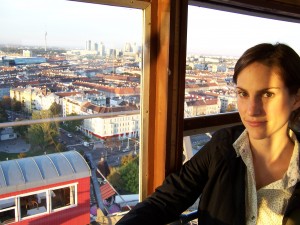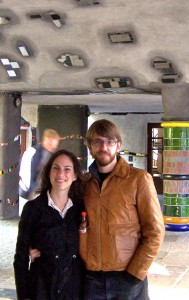The Third Skin | By Lauren Acampora

I needed some plants in my apartment. That’s what got us talking about Friedensreich Hundertwasser, the twentieth-century Austrian artist-architect, on our first date. Thomas told me that Hundertwasser had been a proponent of including greenery—what he referred to as “tree tenants”—within city dwellings. A day or two later, I received a package in the mail containing the catalog from Thomas’s visit to KunstHausWien, the museum that houses much of the artist’s work. More than anything, I was struck by the fact that he’d bothered to mail it from his apartment in Queens to mine in Manhattan.

Along with depictions of vibrant, feverish paintings and carnivalesque buildings, the catalog was peppered with breathless quotations like “The straight line is god-less” and “The third skin is interspersed with windows as the first one is with pores.” The KunstHaus was to serve as “a house of beauty barriers…of uneven floors, of tree tenants and dancing windows….a journey into a country of creative architecture, a melody for eyes and feet.”
I suspected that Thomas and I were headed somewhere when he showed up for our next date with a rubber tree plant—my very own tree tenant.

After we were engaged, we traveled to Vienna together. The KunstHaus was even more fantastic than I’d imagined. The undulating black-and-white exterior is like a warped checkerboard, shot through with color, foliage, and mismatched windows. Inside, the floors are bumpy, like rolling hills. As the artist put it, “It is good to walk on uneven floors and regain our human balance.” Nearly all surfaces seem to be covered in mosaic tiles. (Thomas showed me where, on his first visit, he’d lost a contact lens in the kaleidoscopic bathroom.) The roof is carpeted with grass, which in addition to its ecological benefits was, to Hundertwasser, simply ethical: “The nature we put on the roof is the piece of earth that we murdered by putting the house there in the first place.”
Reading the museum placards, I learned that beyond a prodigious amount of artwork and architecture, he also designed utopian city plans, postage stamps, flags, and license plates, and traveled the world on his sailboat. It was clear that this was one of those rare specimens who seem to possess more hours in the day than other mortals. I’ve known people like this, whose manic creativity sweeps from point to point like a penlight. I’d like to emulate them but lack whatever madness they possess. Instead, these are the types of characters who populate much of my fiction: those driven by their own invisible engines, operating outside of quotidian concerns and chronology, seeming to channel something larger than themselves.
We still have the rubber tree plant. It dropped a few leaves during our years in the city, but it now thrives on a sunlit windowsill of our house in the country. This house is ours to alter as we please, and I have dreams of embellishing the fireplace, the staircase, the front walk with mosaic tiles, if I can ever find the time.
*
NER Digital is a creative writing series for the web. Lauren Acampora’s fiction has appeared in NER (27.3) and other journals, including The Paris Review, Antioch Review, Sonora Review, and Columbia. She lives with her family and tree tenants in upstate New York.